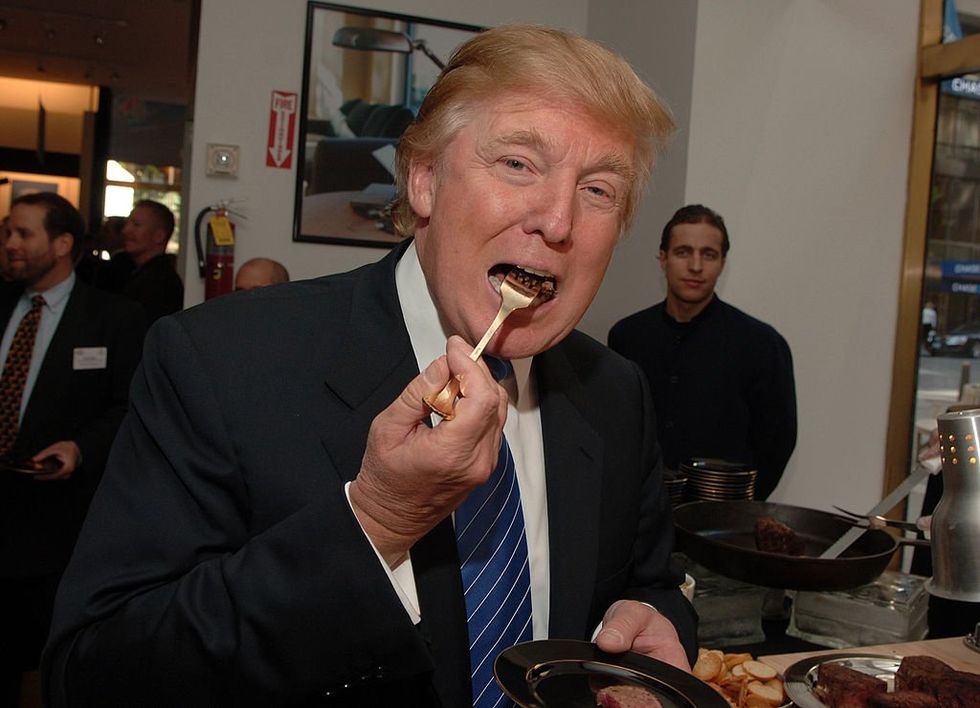Grill, baby, grill! All the best ways to cook a ribeye steak

As Hank Hill would remind us, “If you respect the meat, the meat will respect you.” Whether you’re grilling, smoking, or reverse searing, each method can bring you closer to steak heaven. And in that world, Hank Hill reigns supreme.
Hank Hill is a Christian, an American, and a Texan — in that order. He’s a father, a husband, a propane salesman, and, above all, a disciple of steak.
Buy some bacon ends or other fat chunks, or at least some thick-cut. Chop it up, crisp it up, and put it aside for a steakhouse salad or brussels sprouts or what have you.
He’s the kind of conservative who understands that grilling is not just a way to cook; it’s a moral imperative.
I say this because apparently, “right-wingers are going crazy about meat.”
In Hank’s world, steak is sacred. Apologies to President Trump, but in Hank’s world, anyone wanting his ribeye well done is urged to take his barbaric palate elsewhere: “We ask them politely yet firmly to leave.”
That’s where our journey begins. We’re here to honor steak the way Hank would — with respect, reverence, and a flame. And while there are many ways to cook a ribeye, each method must hold true to the sacredness of beef.
So I talked to as many people as I could about the best ways to cook a ribeye. Let’s start with a fun one.
‘Nom Nom with the Guy Who Fought in Nam’
Josh Jennings is one of the funniest people alive. As a mutual friend put it, Jennings is one of the best creatives for coming up with comedy premises I’ve ever met.
Here’s his take on the revolutionary new way to cook a ribeye.
Joe Pappalardo, author/journalist
While researching an upcoming book about Judge Roy Bean and his brothers, science journalist Joe Pappalardo fell down a rabbit hole of research into the San Antonio street food of the era.
Cubed ribeye steak has become his go-to cut for making traditional Texas chili, with nods to the original San Antonio recipe of the mid-1800s.
The city’s late-night food scene was dominated by female entrepreneurs called “Chili Queens” who set up and tore down street restaurants in the city’s plazas every night. Like modern late-night greasy-spoon diners, they became one of the few places where every strata of San Antonio society commingled.
Staying faithful to the Chili Queen recipe requires using plenty of ancho chiles and cumin — and leaving out the beans. Simmer for as long as you can stand it.
If you’re in San Antonio these days, don’t look for the Chili Queens. The city’s health department shut them down, after nearly 100 years of overnight service, in the early 1940s.
Gaston Mooney, Blaze Media president
For the true steak aficionado, there’s smoking. Blaze Media President Gaston Mooney recommends a thick-cut ribeye, at least two inches, smoking it to 107°F before searing with compound butter. It’s an exercise in patience, one that pairs beautifully with a cold beer and, if you’re feeling fancy, a cigar.
In Argentina, the art of wood-fire grilling includes a unique hand-measuring technique. Grill masters hold their hands over the flames to judge readiness — five seconds and you’re good to go. Too hot? Pull back. Too cool? Wait it out. It’s primal, tactile, and rustic — everything Hank would appreciate.
Nathan Dahlstrom, author
I spoke with Nathan Dahlstrom about the wood-fire approach.
Nathan uses mesquite wood from his own property, grilling his ribeye the old-fashioned way. His process is simple but effective — there’s no thermometer involved, just the feel of the fire and the meat.
Grilling: Propane vs. charcoal
People claim that charcoal tastes better — Hank Hill himself was confronted by the time his wife and son developed a charcoal addiction. But it takes significantly longer and requires a more experienced hand. Whether you’re grilling with propane for speed or opting for the deeper flavor of charcoal, both methods can elevate your steak — so long as it’s not well done.
Lee Moore, Worth the Weight BBQ
This one uses mayo. It’s from Lee Moore, who runs Worth the Weight BBQ.
In 2014, Moore moved from Phoenix to Houston, where trips to famed BBQ joints like Corkscrew BBQ and Truth BBQ fueled his ambition to craft food of a similar caliber.
Starting out with a Traeger from Costco, Moore began understanding the nuances of time versus temperature in BBQ. However, seeking a richer smoke profile, he soon upgraded to a traditional offset smoker he found on Facebook Marketplace, and he discovered the artistry of cooking with real wood.
After a year of hands-on experimentation, Moore encountered Trey at Heirloom Pits and was captivated by his craftsmanship. This led to a leap into a 375-gallon offset — a true piece of art in BBQ equipment.
For Moore, this upgrade underscored that the tools are as essential to the process as the seasonings; just like salt or pepper, quality equipment can elevate the flavors in food. With no formal training beyond BBQ YouTube channels, Moore’s journey reflects the passion and learning that trial and error can foster, turning a backyard cook into a self-taught BBQ aficionado.
Christopher Bedford, Blaze Media senior politics editor
The incomparable Christopher Bedford came through with some recipe gold.
Buy some bacon ends or other fat chunks, or at least some thick-cut. Chop it up, crisp it up, and put it aside for a steakhouse salad or brussels sprouts or what have you.
Buy a bone-in ribeye thick enough to stand on its edge. Don’t forget: Bring your beef (or any meat, really) to room temp before you cook.
Decant your wine. Chill your martini glass. Salt your ribeye with good salt. You can add some garlic powder.
Cook it on its edge, fat down, for about five minutes on medium. Cast iron.
Now that the beef fat has melted into the bacon, put it on its side and cook 1-2 minutes per side, flipping often. Depending on your thickness, you’re looking at a 10+ minute cook, easy. Don’t be afraid. I use a ThermoPro after a while. Get that temperature right.
Baste it with a thick batch of rosemary in between turns, unless you’re topping with bone marrow or blue or something strong-tasting; then just spoon it to keep your flavors from competing.
Take it off 10 degrees before your desired temperature. Place it on the cutting board. Don’t move it for pictures. Don’t do anything to it besides dropping a piece of butter or marrow on it that you need to melt. Don’t even look at it. Ten minutes.
Then slice, platter, lightly flaky Maldon salt or something of similar quality.
Serve. Bask.
‘Unconventional’ methods
Blaze Media’s own Rob Eno swears by sous vide.
He jokes that it’s “pre-Biden” cooking, but the method is solid: slow-cooking the steak in water, sealed in plastic, before searing. For traditionalists, sous vide may sound sacrilegious, but it works. And, as Eno would say, “Don’t knock it till you try it.”
Or what about deep-fried ribeye? Yes, you read that right — deep-frying. Laura Gingrich describes a backyard deep-fried steak as reminiscent of those explosive Thanksgiving turkeys from a decade ago. It’s unconventional, but the end result is crispy, juicy, and indulgent.
Hear me out: A quality ribeye can even be enjoyed raw — think steak tartare. But we’ll save that discussion for another time.
While we’re on a tangent, I should mention that I also received feedback about steak sauce. American cattle rancher Shad Sullivan: “For a great steak, sauce is blasphemy! For a good steak, add a little salt. For overcooked cow leather … pass the A-1!!!!”
Shad’s wife disagrees: “A great steak needs no sauce, but sometimes I need some spice!”
Stoves and ovens
Top-tier steakhouses often use the broiler method. Mastro’s, for example, broils its steaks at 1,500°F and serves them on plates heated to 450°F. Snake-broiling, a hybrid of grilling and broiling, is another approach. First grill, then finish with a quick broil to create a perfect crust.
Pan-searing, especially in cast iron, is another tried-and-true method. The best steakhouses use a butter bath technique, basting with melted butter, garlic, and fresh herbs for that restaurant-quality finish.
If you want to impress someone without too much effort, Blaze News reporter Andrew Chapados suggests a simple technique: “Sear in an oven-safe pan on high for two minutes per side. Then add a tablespoon of butter and finish in the oven at 400°F for 10-12 minutes.”
Loren Poncia, Stemple Creek Ranch co-owner
Use a 1.5 inch thick ribeye. Set it out to room temp. Salt liberally.
Put on a grill or pan at low temperature, like 200-220 degrees, for about five minutes per side or until the center of the steak is 110 degrees.
Remove steak. Crank pan or grill to 500+ and cook steak for one minute on each side.
Reverse sear
This is the most popular response I got.
Home cooks everywhere have evolved their methods, and reverse searing is a testament to that. In the reverse sear, you cook low and slow in the oven till the steak reaches your preferred temperature, then sear in a hot pan on the stovetop to create the crust.
Blaze News staff writer Paul Sacca keeps it simple — season with salt and pepper, sear in olive oil, and baste with butter, smashed garlic, and thyme. It’s a method that can work for nearly any cut, and Hank would approve.
Andrew Patrick Nelson, film historian
I spoke with Andrew Patrick Nelson, the Western apostle himself. I wanted to know about John Wayne’s steak preferences.
Interestingly enough, the Duke was rumored to prefer his steaks well done. There are even Wayne-branded cookbooks, like “The Official John Wayne Guide to Grilling,” that seem to confirm his take on the art of steak. In “The Man Who Shot Liberty Valance,” we witness the most famous steaks in Western film history — massive cuts where the only option for cooking is to “burn ’em!”
Of course, for those who prefer precision, reverse searing is a fine art. As Nelson told me, “For me, rare is the only option. Anything else and you might as well eat a hamburger instead.”










